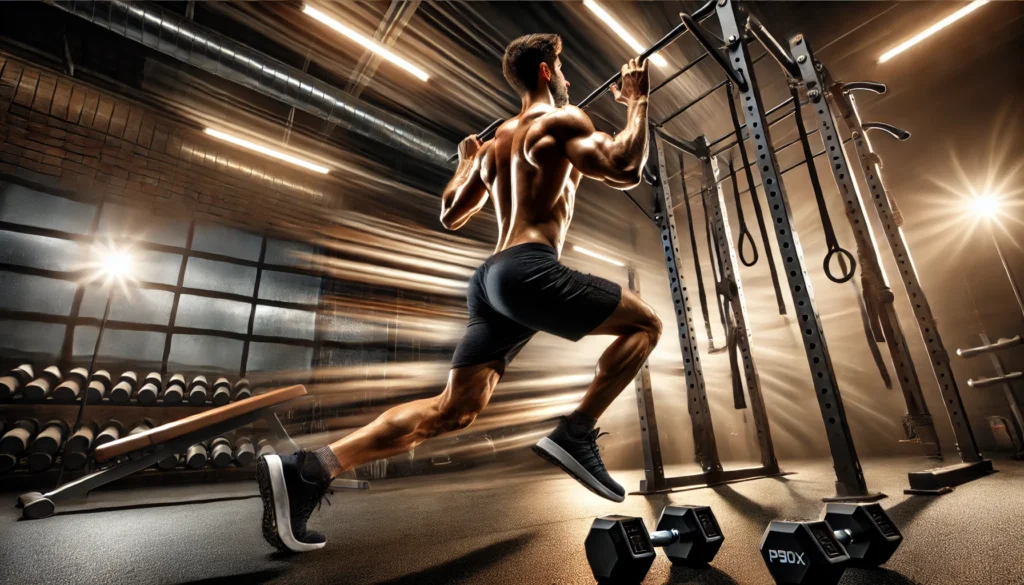P90X is a well-known home fitness program developed by Tony Horton, offering a rigorous workout regimen designed to improve overall fitness through a combination of strength training, cardio, flexibility, and endurance. One of the standout workouts in the P90X system is the Legs and Back routine, which focuses on building lower body strength, enhancing balance, and developing the muscles of the back.
In this article, we’ll take a detailed look at the P90X Legs and Back workout, discussing its components, benefits, and how to perform it effectively. Whether you’re a P90X enthusiast or new to the program, this guide will provide you with a comprehensive understanding of how the Legs and Back routine works and why it’s a critical part of the overall P90X fitness experience.
Understanding the P90X Program
Before diving into the specifics of the Legs and Back workout, it’s helpful to understand the context of the P90X program itself. P90X stands for “Power 90 Extreme,” and it’s a 90-day home fitness system designed to challenge every aspect of fitness. The program emphasizes muscle confusion, which involves frequently changing the exercises to prevent plateaus and to keep the body guessing, leading to continuous progress.
P90X is broken down into several workout types: resistance training, cardio, yoga, plyometrics, and core work. Each workout targets different muscle groups, ensuring a balanced approach to fitness. The Legs and Back workout is one of the more challenging routines in the P90X lineup, requiring both physical strength and endurance.
Overview of the P90X Legs and Back Workout
The P90X Legs and Back workout is a 58-minute session that targets two major areas of the body: the lower body (legs) and the upper body (back). This routine is designed to build strength, stability, and endurance, focusing on the quadriceps, hamstrings, calves, glutes, and back muscles, particularly the lats.
What makes this workout unique is the alternating focus between leg exercises and back exercises. By constantly shifting between lower body and upper body movements, this routine maximizes efficiency and keeps the heart rate elevated, offering a strength-building and cardiovascular workout in one.
Here’s a breakdown of what the workout entails:
- Leg Exercises: These focus on strength, endurance, and balance, with exercises like squats, lunges, and wall sits.
- Back Exercises: The back movements focus primarily on pull-ups and chin-ups, designed to strengthen the latissimus dorsi (lats), rhomboids, trapezius, and other upper back muscles.
- Cardiovascular Benefits: The combination of high-intensity leg work and upper body exercises keeps the heart rate up, providing cardiovascular benefits alongside strength training.
Benefits of the P90X Legs and Back Workout
The Legs and Back workout in P90X offers numerous benefits, making it an essential part of the overall P90X program. Here are some of the key advantages of this workout:
1. Improved Lower Body Strength
The leg exercises in this workout are designed to target the major muscle groups in the lower body. This includes the quadriceps (front of the thighs), hamstrings (back of the thighs), glutes (buttocks), and calves. Building strength in these areas not only enhances overall fitness but also improves functional movements like walking, running, and jumping.
2. Enhanced Back Muscle Development
The back exercises in the routine, which are predominantly pull-ups and chin-ups, help to develop the muscles of the upper back, including the lats, trapezius, and rhomboids. Strengthening these muscles improves posture, reduces the risk of back injuries, and enhances upper body strength for activities like lifting and pulling.
3. Cardiovascular Health
While the workout focuses on strength training, the alternating nature of the exercises and the high-intensity movements help keep your heart rate elevated throughout the session. This means you’re getting a cardiovascular workout in addition to muscle-building exercises, which can improve heart health, endurance, and stamina.
4. Core Stability and Balance
The leg exercises in the Legs and Back workout often require balance and stability, engaging the core muscles as a result. For example, movements like lunges and single-leg squats challenge the stabilizing muscles in the core, improving overall balance and coordination. This functional strength is crucial for everyday activities and athletic performance.
5. Fat Burning and Weight Loss
By targeting large muscle groups in both the legs and back, the P90X Legs and Back workout burns a significant number of calories. The combination of strength training and cardiovascular exercise is an effective way to increase metabolism and promote fat loss, especially when combined with a healthy diet.
Key Exercises in the P90X Legs and Back Routine
The P90X Legs and Back workout features a range of exercises that target both the lower and upper body. Here’s a look at some of the key exercises you’ll encounter in this routine:
1. Balance Lunge
The balance lunge is a powerful lower body exercise that targets the quadriceps, hamstrings, and glutes. It also requires core engagement to maintain stability. Here’s how to perform the balance lunge:
- Stand with your feet together and place one foot behind you on a chair or bench.
- Lower your body into a lunge, keeping your front knee in line with your toes and your back knee close to the ground.
- Push through your front heel to return to the starting position.
- Repeat for the specified number of reps before switching legs.
2. Calf Raises
Calf raises are an effective way to strengthen the calf muscles, which are crucial for activities like running, jumping, and climbing. Here’s how to perform calf raises:
- Stand with your feet shoulder-width apart.
- Slowly rise up onto your toes, lifting your heels off the ground.
- Pause at the top, then lower back down with control.
- Repeat for the specified number of reps.
3. Super Skater
The super skater exercise mimics the motion of a skater and targets the legs and glutes. This movement also challenges your balance and core stability. Here’s how to perform the super skater:
- Start by standing on one leg with your other leg extended behind you.
- Lower your body into a single-leg squat, keeping your core engaged and your arms in front of you for balance.
- Return to the starting position and repeat for the specified number of reps before switching legs.
4. Wall Squats
Wall squats are an isometric exercise that targets the quadriceps and glutes. It’s a simple but effective way to build lower body strength. Here’s how to perform wall squats:
- Stand with your back against a wall and lower your body into a seated position, as if you were sitting in an imaginary chair.
- Hold the position for the specified amount of time, making sure your knees are at a 90-degree angle and your thighs are parallel to the ground.
- Keep your core tight and maintain steady breathing throughout the hold.
5. Pull-Ups and Chin-Ups
The back portion of the P90X Legs and Back workout relies heavily on pull-ups and chin-ups to strengthen the upper back and arms. Pull-ups and chin-ups target the lats, trapezius, biceps, and forearms. Here’s how to perform both:
- Pull-Ups: Grab the pull-up bar with your palms facing away from you (overhand grip). Engage your back muscles and pull your body up until your chin is above the bar. Lower yourself down with control.
- Chin-Ups: Grab the bar with your palms facing towards you (underhand grip). Engage your back and arms to pull yourself up, then lower down with control.
Modifications for Beginners
If you’re new to the P90X program or don’t have the strength to perform all of the exercises in the Legs and Back routine, there are several modifications you can make to ensure you still get a great workout:
1. Assisted Pull-Ups
If you’re not able to perform full pull-ups or chin-ups, consider using a resistance band for assistance. Loop the band around the pull-up bar and place your feet in the band to reduce the amount of weight you’re pulling up. Alternatively, you can use an assisted pull-up machine if you have access to one.
2. Bodyweight Squats
For beginners who find balance lunges or wall squats too challenging, bodyweight squats are a great alternative. They still target the quadriceps, hamstrings, and glutes but don’t require the same level of balance or strength. Focus on proper form and increase the number of reps as you get stronger.
3. Lighter Resistance
If the leg exercises feel too intense, you can reduce the weight or resistance used. For example, when doing calf raises or lunges, you can perform the movements without holding weights or use lighter dumbbells.
4. Shorter Hold Times
For exercises like wall squats, beginners can start by holding the position for a shorter duration, such as 10-15 seconds, and gradually increase the hold time as their strength improves.
Tips for Getting the Most Out of the P90X Legs and Back Workout
To maximize the effectiveness of the P90X Legs and Back workout, it’s important to approach it with the right mindset and technique. Here are some tips to help you get the most out of this challenging routine:
1. Focus on Form
Maintaining proper form is crucial for preventing injury and ensuring that you’re targeting the right muscles. Pay close attention to Tony Horton’s cues in the video and avoid rushing through the movements. Take the time to perform each exercise with
control and precision.
2. Progressive Overload
As you become stronger, it’s important to progressively challenge your muscles to continue making gains. This can be done by increasing the number of reps, adding more weight, or performing more advanced variations of the exercises. Progressive overload helps prevent plateaus and ensures that you’re continually improving.
3. Stay Consistent
Consistency is key to seeing results from the P90X program. Make sure you’re following the workout schedule and performing the Legs and Back routine as prescribed. Skipping workouts or performing them inconsistently will slow down your progress.
4. Prioritize Recovery
The Legs and Back workout is intense, and your muscles will need time to recover. Make sure you’re giving your body adequate rest between workouts and incorporating stretching or foam rolling to aid in recovery. This will help prevent soreness and reduce the risk of injury.
5. Combine with Proper Nutrition
To build muscle and burn fat effectively, it’s important to fuel your body with the right nutrients. Make sure you’re consuming enough protein to support muscle growth and repair, and maintain a balanced diet that includes healthy fats, carbohydrates, and plenty of fruits and vegetables.
Conclusion
The P90X Legs and Back workout is a powerful routine that targets two major areas of the body—the legs and the back—while providing cardiovascular benefits and improving core stability. With a combination of strength-building exercises like lunges, squats, and pull-ups, this workout challenges both beginner and advanced fitness enthusiasts. By following the workout consistently and applying the tips provided in this guide, you’ll be well on your way to developing stronger legs, a more defined back, and improved overall fitness.
Whether you’re looking to sculpt your lower body, improve your upper body strength, or enhance your endurance, the P90X Legs and Back workout is a versatile and effective component of the P90X program that delivers results.
FAQs
1. What is the P90X Legs and Back workout?
The P90X Legs and Back workout is a 58-minute routine that targets the lower body (legs) and the upper body (back) through a combination of strength-building exercises like lunges, squats, and pull-ups.
2. How often should I do the P90X Legs and Back workout?
The P90X program typically schedules the Legs and Back workout once a week, depending on your fitness level and the overall structure of your training plan.
3. Can beginners do the P90X Legs and Back workout?
Yes, beginners can perform the workout by using modifications such as assisted pull-ups, bodyweight squats, and reducing the intensity of the exercises until they build up their strength.
4. What equipment do I need for the Legs and Back workout?
You’ll need a pull-up bar for the back exercises, and optional dumbbells or resistance bands for added intensity in the leg exercises.
5. How can I improve my performance in pull-ups during the workout?
To improve your pull-ups, practice assisted pull-ups with a resistance band, gradually increase the number of reps, and incorporate other back exercises like rows to build strength.
6. Does the Legs and Back workout help with fat loss?
Yes, by combining strength training and cardiovascular exercise, the P90X Legs and Back workout burns calories and can help promote fat loss when paired with a healthy diet.
4o







